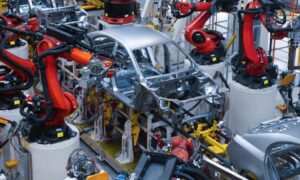In a world where AI algorithms are becoming more prevalent in decision-making processes, it’s crucial to address the issue of hidden biases that can affect their outcomes. Understanding and uncovering these biases is essential for ensuring fair and accurate results. In this blog post, we will explore strategies for detecting bias in AI algorithms and discuss how to mitigate its impact on our technological future. Join us as we delve into the complexities of bias detection and learn how to navigate the ethical challenges of machine learning.
Introduction to bias in AI algorithms
Artificial Intelligence (AI) algorithms have become increasingly prevalent in our daily lives, from social media feeds to job hiring processes. These algorithms are designed to make decisions and predictions based on large amounts of data, with the goal of optimizing efficiency and accuracy. However, like any other human creation, AI algorithms are not immune to biases.
Bias refers to a tendency or predisposition towards certain beliefs or behaviors that may influence decision-making. In the context of AI algorithms, bias can be introduced through the data used to train them, as well as the choices and assumptions made by their developers.
These biases can have serious implications for individuals and society as a whole. For example, biased AI algorithms used in job hiring could perpetuate discriminatory practices against certain groups of people based on factors such as race or gender. Similarly, biased algorithms used in criminal justice systems could lead to unjust outcomes for individuals from marginalized communities.
Types of bias commonly found in AI
There are several types of bias commonly found in AI systems. Understanding these biases is crucial in detecting and mitigating their effects. Here are some of the most commonly encountered biases in AI algorithms:
1. Data Bias
Data bias occurs when the training data used to develop an AI system is not representative of the real-world population it is meant to serve. This can happen due to a variety of reasons, including incomplete or inaccurate data, skewed samples, and underrepresentation of certain demographics. As a result, the algorithm will reflect these biases and produce discriminatory results.
2. Confirmation Bias
Confirmation bias refers to the tendency for people to search for or interpret information in a way that confirms their preconceptions or beliefs. In AI systems, this can lead to biased decisions if there is a lack of diversity in the team developing and testing the algorithm.
3. Selection Bias
Similar to data bias, selection bias occurs when certain groups or characteristics are overrepresented in the training data while others are underrepresented or entirely excluded. For example, if an algorithm used for hiring candidates only evaluates resumes from specific universities or job titles, it may inadvertently discriminate against individuals from other backgrounds.
4. Automation Bias
Automation bias happens when humans blindly trust decisions made by machines without questioning them critically. This type of bias can have severe consequences if an incorrect decision is made by an algorithm due to erroneous input data.
5. Algorithmic Recidivism Bias
Recidivism refers to an individual’s likelihood of reoffending after being released from prison or jail if convicted again within three years since their release date. Anytime there’s justice based purely on an algorithm, there’s a possibility of misuse or failure. Identifying and eliminating biases in the data used for recidivism prediction is crucial to avoid perpetuating systemic inequalities.
6. Gender Bias
Gender bias occurs when AI algorithms exhibit differences in results between individuals based on their gender due to trained data sets that contain gender stereotypes, resulting in unequal treatment.
The impact of bias on society and individuals
The impact of bias on society and individuals is a crucial issue that needs to be addressed when discussing bias in AI algorithms. It refers to the ways in which biased AI systems can perpetuate discrimination, reinforce societal inequalities, and harm both individuals and communities.
One of the major consequences of biased AI algorithms is their potential to perpetuate discrimination and inequality. These algorithms are designed based on existing data, which may reflect historical biases and prejudices. As a result, they can reproduce these biases and further marginalize underrepresented groups. For example, if an AI algorithm used for hiring processes is fed data from past hiring decisions where certain characteristics were favored over others, it will learn this bias and continue to favor those same characteristics in future decision-making processes.
Moreover, biased AI algorithms have the power to reinforce societal inequalities by disproportionately impacting disadvantaged communities. For instance, facial recognition software has been proven to be less accurate when identifying people with darker skin tones or from marginalized communities. This has serious implications for things like criminal justice or border control.
On an individual level, biased AI systems can have a direct impact on people’s lives by limiting opportunities and perpetuating stereotypes. This is particularly evident in areas such as employment, where biased hiring algorithms could prevent qualified individuals from getting hired based on their gender or ethnicity.
Beyond these tangible impacts, biased AI systems also erode trust in technology and institutions. When an individual experiences discrimination or unfair treatment due to a biased algorithm, it not only affects them personally but also damages their perception of the system as a whole. This lack of trust can have far-reaching effects on how technology is adopted and used in society.
It is essential to recognize that the impact of bias goes beyond just those who are directly affected by it – it affects us all as members of society. Biased AI systems contribute to creating an unequal playing field for everyone involved, preventing progress towards a fairer future.
Case studies of biased AI algorithms
Case studies have revealed numerous instances where AI algorithms display biased behavior, often leading to harmful consequences for marginalized groups. In this section, we will explore some notable case studies that shed light on the prevalence and impact of biased AI algorithms in various industries.
One of the most widely known cases is that of Amazon’s recruiting tool, which was designed to screen job applicants by sorting resumes based on certain keywords and qualifications. However, it was found that the algorithm favored male candidates over female ones, penalizing resumes with references to women’s colleges or membership in women’s organizations. This bias can be traced back to the training data used to build the algorithm, which consisted primarily of male resumes from previous successful hires at Amazon. As a result, the company had to scrap this tool after realizing its discriminatory nature.
Another instance of biased AI is seen in facial recognition technology used by law enforcement agencies. A study conducted by researchers at MIT found that facial recognition systems were more likely to misidentify dark-skinned individuals compared to lighter-skinned ones. This has serious implications as these systems are being increasingly integrated into police activities such as surveillance and suspect identification.
The education sector has also been affected by biased AI algorithms. In 2018, an investigation revealed that some school districts in the US were using predictive software to identify students at risk of dropping out based on factors like attendance and grades. However, it was discovered that these systems were disproportionately flagging students from minority groups as “at-risk”, potentially perpetuating stereotypes and hindering their academic progress.
Furthermore, Google’s search algorithm came under scrutiny when it showed racist results for searches related to Black people. For example, searching for “black girls” would result in sexually objectified images while searching for “black teenagers” would bring up mugshots instead of regular images like those shown for searches related to white people.
Strategies for detecting and mitigating bias in AI models
As developers and users of AI technology, it is essential to be aware of potential biases and implement strategies to detect and mitigate them. In this section, we will discuss some effective strategies for uncovering hidden biases in AI algorithms.
1. Understand the Data: The first step in detecting bias in an AI model is understanding the data used to train it. This means thoroughly examining the dataset for any imbalances or skewed representation of specific demographics or groups. Developers should also consider the source of the data as it may carry inherent biases that could reflect in the model’s predictions.
2. Diverse Team: A diverse team with members from different backgrounds can bring a range of perspectives and experiences while developing an AI model. This diversity can help identify potential biases early on in the process and work towards mitigating them.
3. Consistent Evaluation: It is crucial to consistently evaluate an AI model throughout its development process for any signs of bias. This includes testing against different subsets of data representing various demographics, ensuring fair treatment across multiple variables such as race, gender, age etc., and checking for consistency over time.
4.Good Representation: A key aspect of mitigating bias is ensuring good representation within training datasets that accurately reflect real-world situations without under or over-representing certain groups.
5.Audit Trails: Keeping track of decisions made by an AI algorithm through audit trails can help identify where potential biases exist within a system’s decision-making processes.
6.Transparency: Transparency plays a vital role in detecting and mitigating bias in AI models. Making the decision-making process of an AI algorithm transparent can help researchers and developers identify potential biases and take corrective measures.
7.Regular Updates: As societal norms, values, and beliefs continue to evolve, so should AI models. It is essential to regularly review and update an AI model’s training data to ensure it remains relevant, representative, and unbiased.
Ethical considerations when addressing bias in AI
When developing or implementing any artificial intelligence (AI) system, it is important to consider the potential biases that may be present in the data and algorithms. Bias can lead to unfair or discriminatory outcomes for certain groups of people, perpetuating existing inequalities and hindering progress towards a more equitable society. As such, ethical considerations must be taken into account when addressing bias in AI.
One key ethical consideration is ensuring that the data used to train AI systems is itself unbiased. This means thoroughly examining and purging any biased or incomplete data sets before using them to develop algorithms. It is essential to have a diverse team of experts from various backgrounds and perspectives review the data to identify any potential biases. Additionally, constant monitoring and evaluation should be conducted throughout the development process to identify and address any newly uncovered biases.
Another important ethical consideration is transparency. AI systems are often complex in nature, making it difficult for users to understand how they operate and make decisions. To build trust with stakeholders and prevent unintended consequences, developers must make an effort to explain how their algorithms work in simple terms that can be easily understood by non-technical individuals. This not only helps detect potential biases but also allows for accountability if issues do arise.
Furthermore, incorporating diversity into the development process can help mitigate biases from entering AI systems in the first place. By including individuals with diverse backgrounds, perspectives, and experiences on development teams, different viewpoints will be considered during decision-making processes which can help catch and eliminate instances of bias early on.
It’s crucial for developers to continuously monitor for potential biases after implementation as well. Regular audits should be conducted using rigorous testing methods such as sensitivity analysis or fairness testing across different demographic groups. Any discovered disparities should then be addressed promptly through further refinement of algorithms or collecting more representative data sets.
Future developments and challenges in reducing bias in AI technology
The use of artificial intelligence (AI) has become increasingly widespread, with its applications ranging from predicting consumer behavior to making critical decisions in fields such as healthcare and criminal justice. However, there have been growing concerns about the potential biases inherent in AI algorithms, which can have significant implications on individuals and society as a whole.
To address these concerns, researchers and industry leaders are continuously working towards developing strategies to detect and reduce bias in AI technology. One promising development is the emerging field of Explainable AI (XAI), which focuses on creating transparent and interpretable AI systems to understand how they arrive at their decisions. By incorporating transparency into the design process, XAI aims to increase accountability and provide insights into potential sources of bias within the algorithm.
Another avenue for detecting bias in AI algorithms is through data auditing. This involves identifying any biases present within the data used to train an algorithm before it is deployed. Data auditing can be done manually or through automated tools that can help detect patterns or outliers that may perpetuate existing biases.
In addition to detecting bias, efforts are also being made towards mitigating its impact through techniques such as algorithmic debiasing. This involves adjusting an algorithm’s underlying structure or tweaking its training data to minimize biased outcomes. While still in its early stages, this approach holds promise for reducing bias in real-world applications.
Despite these developments, there are still several challenges ahead when it comes to reducing bias in AI technology effectively. One significant obstacle is the lack of diverse representation within both the design teams creating these algorithms and the datasets used for training them. As a result, there may be inherent blind spots that prevent them from considering all potential biases present.
Moreover, even with advances in XAI and algorithmic debiasing techniques, it is challenging to achieve complete elimination of all types of biases due to complex societal factors that influence decision-making processes. This includes historical inequalities and systemic biases, which can be difficult to identify and address in AI algorithms.
Conclusion
As we continue to rely on artificial intelligence in various aspects of our lives, it is crucial that we uncover and address any hidden biases within these algorithms. By understanding the potential for bias and employing strategies to detect and correct it, we can make AI more fair, inclusive, and accurate. Let us strive towards a future where technology empowers all individuals equally without perpetuating harmful biases. Remember, detecting bias in AI is an ongoing process that requires constant vigilance – let’s work together to create a world where technology truly works for everyone.



































